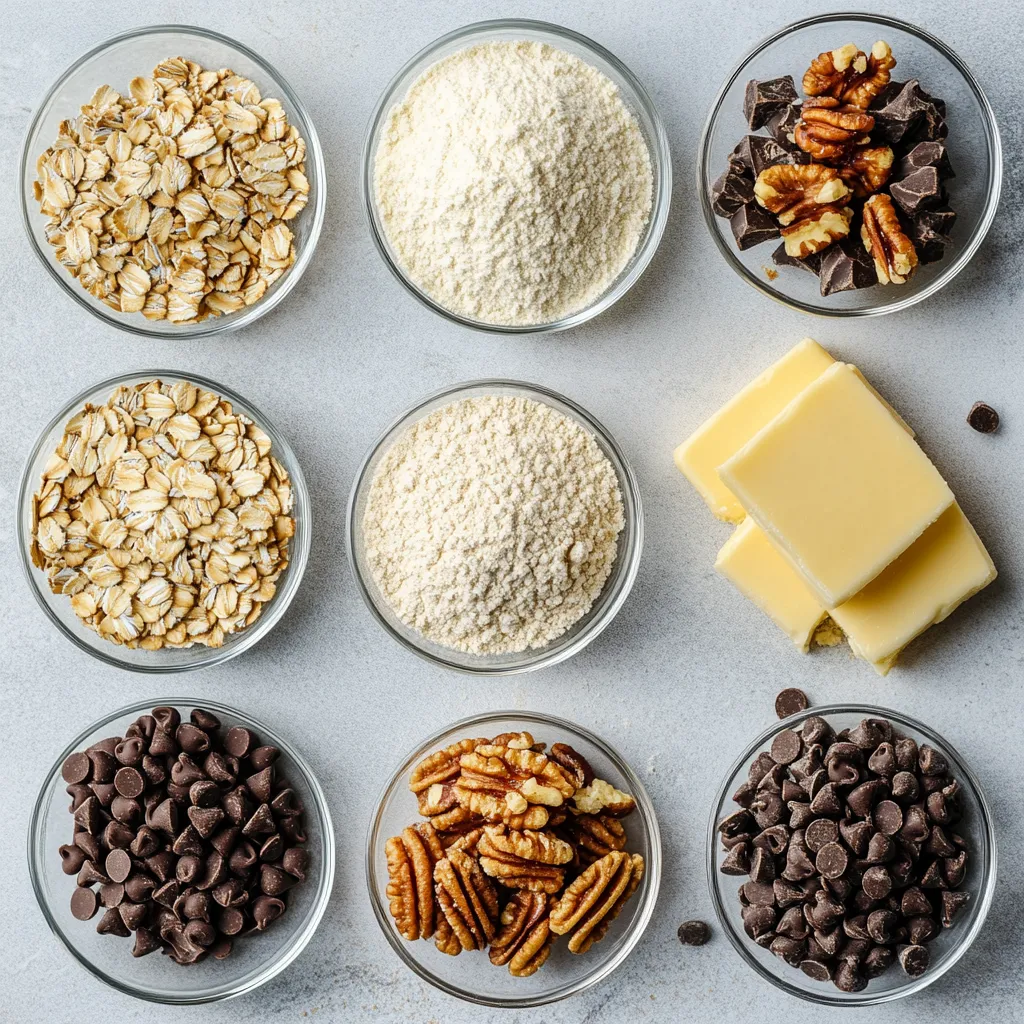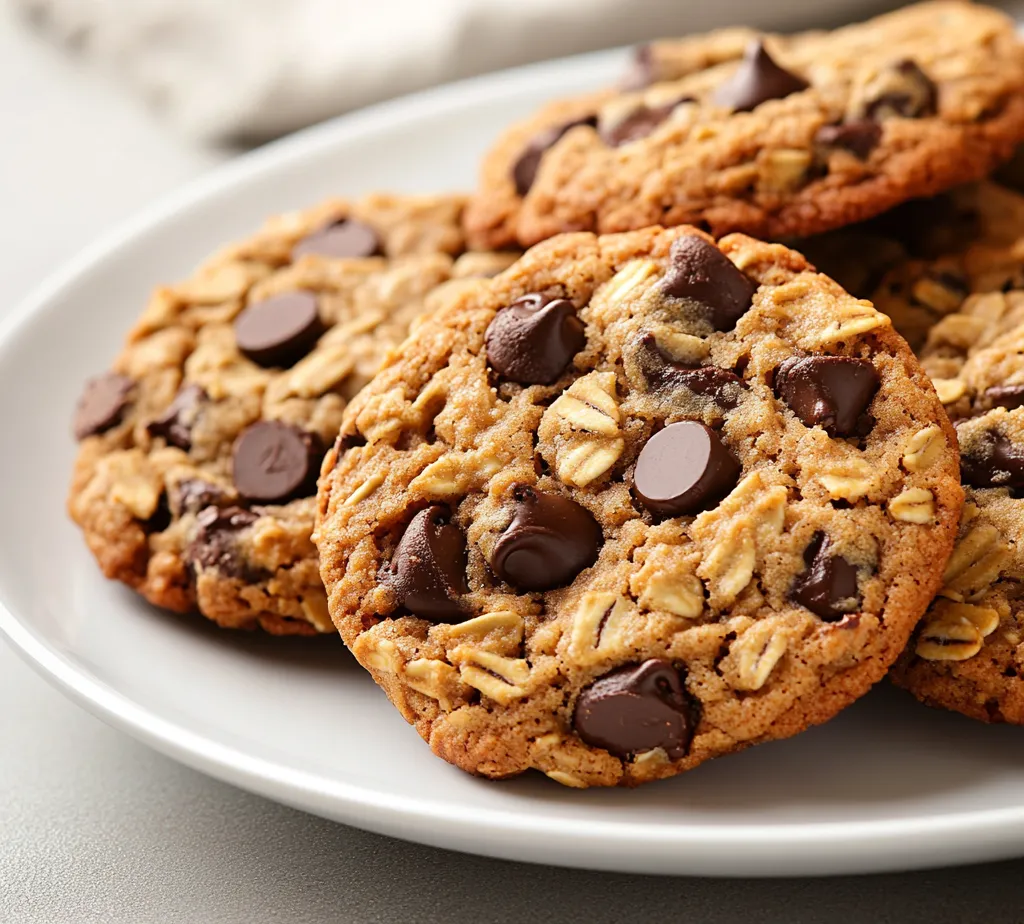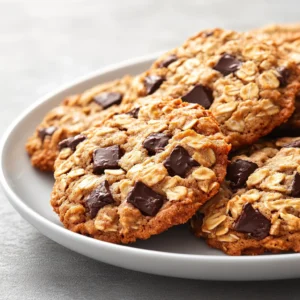Introduction
The classic oatmeal chocolate chip cookie has always held a special place in the hearts of cookie lovers, offering a delightful fusion of wholesome oats and rich, melted chocolate. This Decadent Oatmeal Chocolate Chip Cookies recipe elevates this beloved treat into a deeply satisfying experience that’s perfect for any occasion. Whether you’re baking up a batch for an afternoon snack, a family gathering, or simply to enjoy at home, these cookies will certainly become a favorite.
Made with wholesome rolled oats, a blend of sugars, and plenty of chocolate chips, the texture and flavor of these cookies are guaranteed to please even the pickiest eaters. The comforting aroma of baking cookies wafts through the house, creating a warm and inviting atmosphere that is truly unmatched. Perfect for sharing with friends, gifting, or indulging in on a cozy evening, these cookies are sure to become a staple in your baking repertoire.
Recipe Overview
– Total Time: 30 minutes
– Prep Time: 15 minutes
– Servings: About 24 cookies
– Difficulty: Not specified in the recipe
Ingredients
– 1 cup rolled oats
– 1 cup all-purpose flour
– 1/2 cup packed brown sugar
– 1/2 cup granulated sugar
– 1/2 cup unsalted butter, softened to room temperature
– 1 large egg
– 1 teaspoon pure vanilla extract
– 1/2 teaspoon baking soda
– 1/2 teaspoon baking powder
– 1/4 teaspoon salt
– 1 cup semi-sweet chocolate chips
– 1/2 cup chopped walnuts or pecans (optional)

Instructions
1. Preheat the Oven: Begin by preheating your oven to 350°F (175°C). Line a baking sheet with parchment paper to prevent sticking and ensure easy cleanup.
2. Prepare Dry Ingredients: In a medium mixing bowl, thoroughly combine the rolled oats, all-purpose flour, baking soda, baking powder, and salt. Mix well and set this dry mixture aside for later use.
3. Cream Butter and Sugars: In a large mixing bowl, use an electric mixer to cream together the softened butter, packed brown sugar, and granulated sugar. Beat the mixture on medium speed until it becomes light and fluffy, which should take about 2-3 minutes.
4. Incorporate Egg and Vanilla: Add the large egg and pure vanilla extract to the creamed butter mixture. Mix until both are fully incorporated and the mixture is smooth.
5. Combine Wet and Dry Mixtures: Gradually add the dry ingredients to the wet mixture, stirring until just combined. Be careful not to overmix, as this can lead to tough cookies.
6. Fold in Chocolate Chips and Nuts: Gently fold in the semi-sweet chocolate chips and, if desired, the chopped walnuts or pecans. Ensure these ingredients are evenly distributed throughout the cookie dough.
7. Scoop the Dough: Using a cookie scoop or a tablespoon, drop rounded portions of dough onto the prepared baking sheet. Make sure to leave enough space between each scoop to allow for spreading during baking.
8. Bake the Cookies: Place the baking sheet in the preheated oven and bake for 10-12 minutes. The cookies are done when the edges are golden brown, while the centers may appear slightly underbaked; they will continue to firm up as they cool.
9. Cool Down: Once baked, remove the cookies from the oven and allow them to cool on the baking sheet for about 5 minutes. Then, transfer them to a wire rack to cool completely.
Rolled Oats
Rolled oats are a crucial ingredient in this recipe, providing the traditional chewy texture that distinguishes oatmeal cookies. They not only contribute to the overall structure but also enhance the cookies’ nutritional profile. Oats are rich in fiber, which can aid in digestion and provide a sense of fullness. Utilizing rolled oats rather than quick oats is essential here, as they retain their texture and provide the desired bite in each cookie.
In a world where health-conscious choices are on the rise, incorporating oats into your baking adds a wholesome touch. These cookies not only satisfy the sweet cravings but do so with the goodness of oats. Additionally, oats are a source of vitamins and minerals that contribute to overall well-being, making these cookies a delicious yet nourishing option for all.
All-Purpose Flour
All-purpose flour is the backbone of many baked goods, providing the essential structure needed for cookies. In this recipe, it balances perfectly with the rolled oats, creating a cohesive dough that holds its form during baking. The right type of flour is pivotal; all-purpose flour has the ideal protein content that allows for proper gluten development, which contributes to the cookie’s texture and chewiness.
While the recipe calls specifically for all-purpose flour, bakers might wonder if there are alternatives they can consider. Options like whole wheat flour or a gluten-free blend can be used, but alterations may slightly affect the texture and flavor. If choosing to experiment with different flours, be mindful of their protein content and how it will influence the final outcome.
Sugars
The combination of brown sugar and granulated sugar plays a significant role in achieving the right flavor and texture for these cookies. Brown sugar, packed into the measuring cup, adds moistness and a slightly caramel-like flavor thanks to its molasses content. In contrast, granulated sugar contributes to the cookie’s crisp edges, creating a delightful contrast to the chewy center.
The interplay of these sugars is what makes each cookie extraordinary. Brown sugar not only provides sweetness but also a depth of flavor that complements the chocolate chips beautifully. The balance of both types of sugar in this recipe ensures that each bite is flavorful and satisfying.
Butter
Using unsalted butter in this recipe is crucial for achieving the perfect cookie texture. Unsalted butter allows bakers to control the salt level in the dough, ensuring that the sweet and savory notes can shine through without being overwhelmed. The softness of the butter, which should be at room temperature before you begin mixing, is also essential for creaming together with the sugars.
Softened butter incorporates air into the mixture, resulting in a fluffy texture that ultimately affects the cookies’ rise and mouthfeel. Hard butter would be difficult to cream, resulting in a denser cookie. Therefore, allowing the butter to soften ensures the right consistency and promotes optimal embedding of the sugars and the egg in the blend.
Egg
Eggs serve multiple purposes in baking, acting as a binding agent, adding moisture, and helping with the cookie’s structure. The presence of one large egg helps amalgamate the ingredients, ensuring that the fats from the butter and the dry components unite seamlessly, which gives the cookies their cohesive structure.
For those looking to replace eggs in their baking, alternatives such as flaxseed meal, applesauce, or commercial egg replacers could be considered. However, each alternative will produce slightly different results, particularly in terms of texture and binding capabilities. If sticking to the classic recipe, including the egg is paramount for achieving those chewy cookies everyone loves.
Vanilla Extract
Pure vanilla extract may seem like a small addition to the ingredient list, but it holds significant weight in terms of flavor development. Vanilla enhances the overall taste of cookies by rounding out the sweetness and complementing the chocolate chips. It provides a warm undertone that enriches the cookie’s flavor profile.
When purchasing vanilla extract, it’s advisable to opt for pure rather than imitation vanilla, as the latter can lack the complexity and depth of flavor essential for delightful desserts. Using pure vanilla extract is a simple yet impactful way to elevate your cookies and leave a lasting impression with their irresistible aroma.

Techniques for Folding in Dry Ingredients Without Overmixing
Folding in dry ingredients is a crucial step in cookie preparation, as this step can significantly affect the final texture of your cookies. To avoid overmixing, which can toughen the dough, use a spatula or a wooden spoon instead of an electric mixer. Start by adding the dry ingredients to the wet mixture gently. Incorporate the flour mixture in two or three additions, carefully lifting and turning the mixture over rather than stirring vigorously. Aim to mix until just combined, leaving small streaks of flour visible; this will ensure your cookies remain soft and tender.
Importance of Maintaining the Dough’s Texture
The texture of the cookie dough is vital for achieving the desired consistency of your finished cookies. The goal is to create a dough that is smooth yet slightly sticky. Ensure that your butter is well-creamed, but not overbeaten after the addition of the egg and vanilla, as this can lead to a heavy cookie. Remember, the less you handle the dough, the more tender your cookies will be once baked.
Adding Chocolate Chips and Nuts
How to Gently Fold in Chocolate and Nuts for Even Distribution
When it comes to folding in the chocolate chips and optional nuts, treat your dough delicately to maintain its structure. As with the dry ingredients, sprinkle the chocolate chips and nuts over the dough, and gently fold them in using your spatula. This method prevents the dough from becoming overworked, allowing you to create delicious cookies with a perfect distribution of sweet chocolate and crunchy nuts.
Ideas for Customizing This Step Based on Personal Preferences
The beauty of these cookies lies in their versatility. You can customize your cookie dough by incorporating your favorite flavors or textures. Consider using dark chocolate chips for a richer chocolate taste or swapping walnuts for pecans based on your texture preference. Additionally, you might choose to include dried fruits like cranberries or cherries for a tart contrast to the sweetness of the chocolate.
Scooping the Dough
Using Cookie Scoops
A cookie scoop is an essential tool for achieving uniform cookies. These scoops come in various sizes and help you measure out equivalent portions, ensuring that each cookie bakes consistently. The advantage of using a cookie scoop lies not only in the aesthetic uniformity of the cookies but also in the predictable baking time.
Alternative Methods for Dough Portioning
If you do not have a cookie scoop, using two spoons is a viable alternative. Take a spoonful of dough from the mixing bowl with one spoon and use another to push it off onto the baking sheet. However, this method may result in slightly less uniform cookies. Regardless of the method you choose, ensure that the dough portions are roughly the same size for even baking.
Arranging on Baking Sheet
Guidelines for Spacing Out Cookie Dough
When placing your cookie dough on the prepared baking sheet, leave adequate space between each scoop. Generally, a distance of about 2 inches is ideal. This spacing allows the cookies to spread while baking without merging into one another, ensuring that each cookie retains its shape.
Importance of Allowing Space for Spreading While Baking
Proper spacing is critical to achieving the right texture and appearance of your cookies. Should the cookies be too close together, they can bake into one large cookie rather than individual treats, affecting their chewyness and the delightful texture that makes these cookies so appealing.
Baking the Cookies
Optimal Baking Temperature
Baking at 350°F (175°C) is standard for cookie recipes, and it strikes a balance, allowing the cookies to spread out while cooking through properly. A consistent baking temperature ensures that cookies rise adequately and that the edges brown evenly without burning.
Baking Time
The baking time for these cookies is between 10-12 minutes. An indicator that the cookies are ready is when the edges are golden brown, but the centers may still appear slightly undercooked. They will continue to firm up as they cool, resulting in a soft and chewy interior. If your oven runs hot or cool, consider adjusting the time accordingly, checking for doneness a minute or two earlier or later than instructed.
Cooling the Cookies
Cooling on Baking Sheet
After removing the cookies from the oven, allow them to cool on the baking sheet for approximately 5 minutes. This resting time helps set the cookies’ structure and prevents them from crumbling when transferred to a cooling rack.
Importance of Wire Racks for Cooling
Transferring cookies to a wire rack is crucial for them to cool evenly. Using a spatula, gently slide the cookies onto the rack, ensuring they do not break apart. This method also prevents sogginess since the air circulates around the cookies, allowing moisture to escape.
Presentation Tips
Visually Appealing Servings
For a delightful presentation, serve your cookies on a beautiful platter or stack them neatly. You may want to garnish them with a light sprinkle of sea salt or a dusting of cocoa powder to enhance visual appeal and flavor.
Pairing with Beverages
These oatmeal chocolate chip cookies pair wonderfully with various beverages. A glass of cold milk is a classic choice, while a warm cup of coffee or tea can complement the rich flavors of the cookies. For an indulgent experience, consider serving them alongside a scoop of vanilla ice cream.
Storing Leftovers
Proper Storage Techniques
To maintain freshness, store leftover cookies in an airtight container at room temperature. This method keeps them soft and chewy for several days. If you have many cookies, consider stacking parchment paper between layers to prevent sticking.
Tips on Freezing Cookies for Longer Shelf Life
For longer storage, freezing cookies is an excellent option. Transfer the cooled cookies to a freezer-safe bag or container, ensuring as much air as possible is removed to prevent freezer burn. They can be frozen for up to three months. For best results, allow them to come to room temperature before enjoying.
Reheating Cookies
Methods for Reheating Cookies to Restore Softness
To rejuvenate your cookies, place them in a 350°F (175°C) oven for about 5-7 minutes. This method will restore their warmth and softness without drying them out. Alternatively, you can use a microwave, heating them for 10-15 seconds.
Importance of Not Overcooking During Reheating
While reheating, cautiously monitor the cookies to prevent overcooking, which can lead to a hard texture. The goal is to warm them just enough to enjoy the gooey chocolate and soft centers.
Flavor Variations
Alternate Add-ins
Consider enhancing your cookies by introducing various mix-ins. Other types of chocolate, such as white or milk chocolate chips, can create a different flavor profile. You might also try adding shredded coconut, dried fruits, or a sprinkle of spices like cinnamon or nutmeg for a unique twist.
Customizing Sweetness Levels
Adjusting the sugar levels can accommodate personal preferences. If you prefer less sweetness, feel free to reduce the amount of sugar slightly while maintaining the cookie’s balance with other ingredients. It’s essential to strike a balance between flavors, especially when incorporating richer chocolate or tart fruits.
Conclusion
These oatmeal chocolate chip cookies are a harmonious blend of chewiness and richness, offering a delightful treat. With a preparation time of approximately 30 minutes, they’re an enticing option for both casual snacking or special occasions. The combination of oats and chocolate creates a satisfying texture that is sure to please all palates.

Decadent Oatmeal Chocolate Chip Cookies Recipe
Ingredients
- 1 cup rolled oats
- 1 cup all-purpose flour
- ½ cup packed brown sugar
- ½ cup granulated sugar
- ½ cup unsalted butter softened
- 1 large egg
- 1 teaspoon pure vanilla extract
- ½ teaspoon baking soda
- ½ teaspoon baking powder
- ¼ teaspoon salt
- 1 cup semi-sweet chocolate chips
- ½ cup chopped walnuts or pecans optional
Instructions
- Preheat your oven to 350°F (175°C) and line a baking sheet with parchment paper.
- In a medium bowl, combine rolled oats, flour, baking soda, baking powder, and salt.
- In a large bowl, cream together softened butter, brown sugar, and granulated sugar until light and fluffy.
- Add the egg and vanilla extract to the butter mixture and mix until smooth.
- Gradually add the dry ingredients to the wet mixture, stirring until just combined.
- Fold in chocolate chips and optional nuts until evenly distributed.
- Drop rounded portions of dough onto the prepared baking sheet, leaving space between each scoop.
- Bake for 10-12 minutes until edges are golden brown; centers may be slightly underbaked.
- Cool on the baking sheet for 5 minutes before transferring to a wire rack to cool completely.

